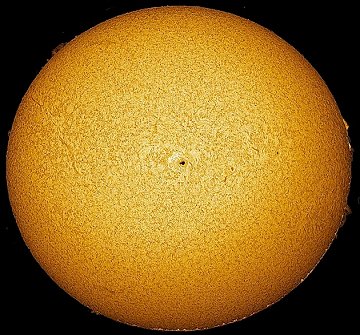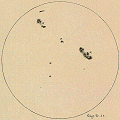 Would you like a call when the ISS is about to fly over your backyard? Sign up for SpaceWeather PHONE.
Would you like a call when the ISS is about to fly over your backyard? Sign up for SpaceWeather PHONE.
AURORA WATCH: Later today or tomorrow, Earth will pass through a solar wind stream spewing from a coronal hole on the sun. Sky watchers in Alaska, Canada and Scandinavia should be alert for auroras.
SUNSPOTS: Magnetic fields around sunspot 735 have been twisting, stretching and growing more complicated since the beginning of the week. If the trend continues, there could be a magnetic eruption--in other words, a solar flare. NOAA forecasters estimate a 15% chance of an M-class flare during the next 24 hours.
In Rockville, Maryland, on February 16th, Greg Piepol took this picture of the sun. Sunspot 735 is in the middle pointing directly at Earth:

more images: from Gary Palmer of Los Angeles, CA; from Laurent Laveder of Quimper, Bretagne, France; from Eric von der Heyden of Darmstadt, Germany; from Didier Favre of Los Angeles, CA, USA [more]
HAPPY BIRTHDAY, GALILEO: On February 15, 1564, Galileo Galilei was born in Pisa, Italy. If he were alive today he would be 441 years old. Galileo is an important person in the history of space weather. Contrary to popular belief, he didn't discover sunspots, but he was one of the first to observe them using a telescope.
 In Galileo's day, many people believed sunspots were satellites of the sun. Galileo proved otherwise. By drawing sunspots every day, he discovered that the sun spins and that sunspots are located on (or very near) the sun's surface. Galileo thought sunspots might be clouds.
In Galileo's day, many people believed sunspots were satellites of the sun. Galileo proved otherwise. By drawing sunspots every day, he discovered that the sun spins and that sunspots are located on (or very near) the sun's surface. Galileo thought sunspots might be clouds.
Right: Sunspots drawn by Galileo in June 1612. [more drawings]
Now we know what sunspots really are: magnetic islands. Sunspots consist of magnetic force-fields poking through the sun's surface from below. Sometimes these magnetic fields erupt, producing a solar flare. With a temperature of "only" a few thousand degrees C, sunspots are cooler than their surroundings and, thus, they appear dark. Sunspots are as big as planets.
Do-it-yourself Sunspot Observing Tips

